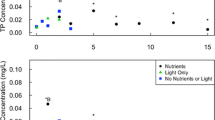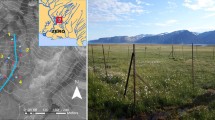Abstract
Herbivory and fire have been shown to affect the structure and composition of marsh communities. Because fire may alter plant species composition and cover, and these alterations may have an effect on herbivore populations or foraging patterns, an interactive effect of herbivory and fire may be expected. In this study, the effects of fire and vertebrate herbivory in a Louisiana oligohaline marsh were studied using small, controlled burns and animal exclosures. Mean total biomass was nearly 2 times greater in the plots protected from herbivory than in the plots subject to natural herbivory. Additionally, mean total biomass was over 1.5 times greater in the plots that remained unburned than in those that were burned. Two dominant perennial species,Spartina patens andScirpus olneyi, were negatively affected by herbivory, but two annual sedges,Cyperus flavescens andCyperus odorata, were positively affected. Burning reduced the aboveground biomass ofSpartina patens andBacopa monnieri. No species increased in biomass as a result of fire. No significant differences were found in species richness between herbivory treatments or between fire treatments. Although both herbivory and fire were found to cause significant changes in the vegetation, the interaction between herbivory and fire was not found to produce any significant effects in any test conducted.
Similar content being viewed by others
Literature Cited
Allan, P.F. 1950. Ecological base for land use planning in Gulf coast marshlands. Journal of Soil and Water Conservation 5:57–62.
Bakker, J.P. 1985 The impact of grazing on plant communities, plant populations, and soil conditions on saltmarshes. Vegetatio 63:391–398.
Bazely, D.R. and R.L. Jefferies. 1986. Changes in the composition and standing crop of salt-marsh communities in response to the removal of a grazer. Journal of Ecology 74:693–706.
Bjorkman, C. and D.B. Anderson. 1990. Trade-off among antiherbivore defences in South American blackberry. Oecologia 85: 247–249.
Boeclen, W.J., P.W. Price, and S. Mopper. 1990 Sex and drugs and herbivores: Sex-biased herbivory in arroyo willow (Salix lasiolepis). Ecology 71:581–588.
Boorman, L.A. and R.M. Fuller. 1981. The changing status of reedswamp in the Norfolk Broads. Journal of Applied Ecology 18: 241–269.
Cartwright, B.W. 1942. Regulated burning as a marsh management technique. Transactions of the North American Wildlife Conference 7:257–263.
Caswell, H., F. Reed, S.N. Stephenson, and P.A. Werner. 1973. Photosynthetic pathways and selective herbivory: A hypothesis. American Naturalist 107:465–480.
Chabreck, R.H. 1959. A study of nutria exclosures in southwest Louisiana. Final Report to Louisiana Wildlife and Fisheries Commission. Baton Rouge, LA, USA.
Chabreck, R.H. 1976. Management of wetlands for wildlife habitat improvement. p. 226–233.In M. Wiley, (ed.) Estuarine Processes, Volume I. Uses, stresses, and adaptation to the estuary. Academic Press, New York, NY, USA.
Chabreck, R.H. 1982. Effect of burn date on regrowth rate ofScirpus olneyi andSpartina patens. Proceedings of the Annual Conference of the Southeastern Association of Fish and Wildlife Agencies 35:201–210.
Chabreck, R.H. and R.E. Condrey. 1979. Common vascular plants of the Louisiana marsh. Sea Grant Publication No. LSU-T-79-003. Louisiana State University Center for Wetland Resources, Baton Rouge, LA, USA.
Conner, W.H. 1989. The nutria problem—Part III: Reply to Rebuttal. Aquaphyte 9:14.
Evans, J. 1970. About nutria and their control. U.S. Fish and Wildlife Service Resource Publication 86. Denver, CO, USA.
Foote, A.L., J.A. Kadlec, and B.K. Campbell. 1988. Insect herbivory on an inland brackish wetland. Wetlands 8:67–74.
Fuller, D.A., C.E. Sasser, W.B. Johnson, and J.G. Gosselink. 1985. The effects of herbivory on vegetation on islands in Atchafalaya Bay, Louisiana. Wetlands 4:105–114.
Garren, K.H. 1943. Effects of fire on vegetation of the southeastern United States. Botanical Review 9:617–654.
Goldberg, M., N.R. Tabroff, and R.H. Tamarin. 1980. Nutrient variation in beachgrass in relation to beach vole feeding. Ecology 61:1029–1033.
Hess, T.J. Jr. 1975. An evaluation of methods for managing stands ofScirpus olneyi. M.S. Thesis, Louisiana State University. Baton Rouge. LA, USA.
Joenje, W. 1985. The significance of waterfowl grazing in the primary vegetation succession on embanked sandflats. Vegetatio 62: 399–406.
Kantrud, H.A. 1986. Effects of vegetation manipulation on breeding waterfowl in prairie wetlands—a literature review. U.S. Fish and Wildlife Service Technical Report 3. Washington, DC, USA.
Kinler, N.W., G. Linscombe, and P.R. Ramsey. 1987. Nutria. p. 327–342.In M. Novak, J.A. Baker, M.E. Obbard, and B.E. Malloch, (eds.), Wild Furbearer Management and Conservation in North America. The Ontario Trappers Association, Foronto, Ontario, Canada.
Kirby, R.E., S.J. Lewis, and T.N. Sexon. 1988. Fire in North American Wetland Ecosystems and fire-wildlife relations: an annotated bibliography. U.S. Fish and Wildlife Service, Office of Biological Services. Washington, DC, USA. FWS/Biological Report 88/1.
Lay, D.W. 1945. Muskrat investigations in Texas. Journal of Wildlife Management 9:56–76.
Lay, D.W. and T. O’Neal. 1942. Muskrats on the Texas coast. Journal of Wildlife Management 6:301–311.
Linduska, J. 1960. Fire for bigger game crops. Sports Afield 143: 30–31, 88–90.
Linscombe, G., N. Kinler, and V. Wright. 1981. Nutria population density and vegetative changes in brackish marsh in coastal Louisiana. p. 129–141.In J.A. Chapman and A. Purseley (eds.) Proceedings of the Worldwide Furbearer Conference Frostburg, MD, USA.
Lowery, G.H. 1974. The mammals of Louisiana and its adjacent waters. Louisiana State University Press, Baton Rouge, LA, USA.
Mallik, A.V. and R.W. Wein. 1986. Response of aTypha marsh community to draining, flooding, and seasonal burning. Canadian Journal of Botany 64:2136–2143.
Martz, G.F. 1967. Effects of nesting cover removal on breeding ducks. Journal of Wildlife Management 31:236–247.
Mendelssohn, I.A., K.L. McKee, and R. Chabreck. 1988. The influence of burning on the growth response ofScirpus olneyi to saltwater intrusion and subsidence. Final Report of Funded Projects FY 87-88, Board of Regents’ Rockefeller Fund Interest Earnings Grant Program, Louisiana State University, Baton Rouge, LA, USA.
Messinger, R.D. 1974. Effects of controlled burning on waterfowl nesting habitat in northwest Iowa. M.S. Thesis. Iowa State University, Ames, Iowa, USA.
Packard, R.L. 1967. Octodentoid, Bathyergoid, and Ctenodactlyoid rodents. p. 273–290.In S. Anderson and J.K. Jones Jr. (eds.) Recent Mammals of the World. The Ronald Press Co., New York, NY, USA.
Rejmanek, M. J. G. Gosselink, and S.E. Sasser. 1990. Herbivorydependent facilitation succession in the Atchafalaya delta, Louisiana. Bulletin of the Ecological Society of America, Supplement to 71:298.
SAS. 1987. SAS/SYSTAT guide for personal computers, version 6 edition. SAS Institute, Cary, NC, USA.
Shaffer, G., C.E. Sasser, J.G. Gosselink and M. Rejmanek. 1990. A decade of vegetation dynamics in the emergent Atchafalaya delta, Louisiana. Bulletin of the Ecological Society of America, Supplement to 71:322–323.
Smith, L.M. 1988. Lack of herbivory in playa wetlands. Wetlands 8:193–197.
Smith, L.M. and J.A. Kadlec. 1985. Fire and herbivory in a Great Salt Lake marsh. Ecology 66:259–265.
Smith, L.M., J.A. Kadlec, and P.V. Fonesbeck. 1984. Effects of prescribed burning on nutritive quality of marsh plants in Utah. Journal of Wildlife Management 48:285–288.
Sokal, R.R. and J.L. Rohlf. 1981. Biometry, 2nd Ed. W.H. Freeman and Company, New York, NY, USA.
Woods, C.A. and E.B. Howland. 1979. Adaptive radiation of capromyid rodents: anatomy of the masticatory apparatus. Journal of Mammalogy 60:95–116.
Author information
Authors and Affiliations
Rights and permissions
About this article
Cite this article
Taylor, K.L., Grace, J.B., Guntenspergen, G.R. et al. The interactive effects of herbivory and fire on an oligohaline marsh, Little Lake, Louisiana, USA. Wetlands 14, 82–87 (1994). https://doi.org/10.1007/BF03160624
Received:
Accepted:
Issue Date:
DOI: https://doi.org/10.1007/BF03160624




